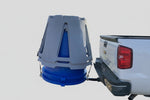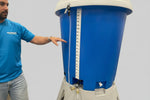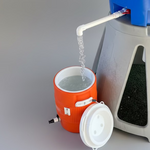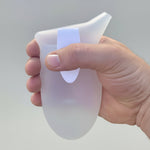Hydration is important year-round, but especially during spring sports season when temperatures spike and extra fluids are lost during exercise. If your fluid loss is not replenished, this could lead to sports-related injuries and potentially life-threatening, heat-related injuries such as heat stroke. The best way to stay properly hydrated is to pre-hydrate before you start any physical activity and stay hydrated throughout the activity with a WaterMonster hydration system. Keep reading for proper hydration guidelines for spring sports.
Hydrate Before You Exercise
It’s no secret that hydration during physical activity is extremely important to staying healthy and avoiding dehydration-related issues. Just as important as hydrating during physical activity is hydrating before you even begin physical activity. Our WaterMonster hydration system allows for cool and refreshing hydration to help you prepare for any activity. Here are a few pre-hydration strategies we recommend:
Consume 500-600 ml of water or a sports drink at least two to three hours prior to physical activity.
Consume 200-300 ml of water or a sports drink at least 10 to 20 minutes prior to physical activity.
You should begin all physical activities properly hydrated to ensure no dehydration occurs during, or after, physical activity.
Proper Spring Sports Hydration Strategies
Individuals who are participating in activities with frequent breaks, such as football, softball, baseball, and track and field, should consume small volumes of liquid at regular intervals. For athletes who are participating in activities where breaks only occur during time-outs or between quarters––like running, field hockey, soccer, and lacrosse––they should ingest enough fluids to maximize their hydration levels. Remember, if you feel thirsty it means your body has been needing hydration for some time. Don’t wait until your mouth is dry to drink water, especially when playing sports. Our WaterMonster hydration system is perfect for any sporting event to keep athletes and attendees hydrated and healthy.
It’s important to note that you should be paying attention to your sweat to decide how much fluid intake is necessary to compensate for fluid loss.
Post-Exercise Hydration Strategies
The primary goal of rehydrating after physical activity is to immediately return the body back to physiologic function. You should drink hydrating fluids within two hours after physical activity.
These fluids consist of water, carbohydrates, and electrolytes to restore your body’s hydration status, and glycogen stores to speed up the rehydration process.
Make sure the fluids you drink are free of fructose, caffeine, and carbonation. We recommend you consume fluids with a temperature of 10 to 15 degrees for optimal rehydration.
Signs of Dehydration
If lost fluids are not replaced within the recommended time, you risk dehydration which can lead to other issues ranging from mild to life-threatening, including:
- Thirst
- Irritability
- Headaches
- Weakness
- Dizziness
- Cramps
- Chills
- Nausea
- Decreased performance
Heat Illnesses and How to Treat Them
An individual who is dehydrated, conscious, and cognizant can be treated with aggressive oral hydration to prevent the occurrence of a heat illness. Cramps––Signs of heat cramps include muscle twitching and cramps in arms, legs, and abdomen. Heat cramps can be treated by increased fluid intake, stretching, and resting in a cool place. Having a WaterMonster hydration system handy at your outdoor events helps to combat heat-related illnesses for both athletes and attendees.
Exhaustion––Heat exhaustion is the result of moderate heat fatigue. Symptoms of heat exhaustion include sweating, increased thirst, weakness, dizziness, headache, and skin that is gray, ashy, cold, or clammy. Treatment for heat exhaustion includes an increase in fluid and electrolytes and resting in a cool place.
Stroke––A heat stroke is a severe illness and a medical emergency. Signs and symptoms of heat stroke include skin that is hot and dry, irritability, disorientation, glassy eyes, rapid pulse, and low blood pressure. Emergency treatment for a heat stroke is life or death. Treatment should involve decreasing body temperature with ice or ice towels and transportation to an Emergency Room.
Athletic performance is always at its best when adequate hydration is maintained. To stay hydrated during spring sports, it’s important that you hydrate before and after any physical activity––so that you can go longer and harder.
We deliver pure, refreshing water through our WaterMonster hydration system for optimal hydration. Do you need to make a bulk order? No problem! Contact us today and we will help you schedule a delivery.








